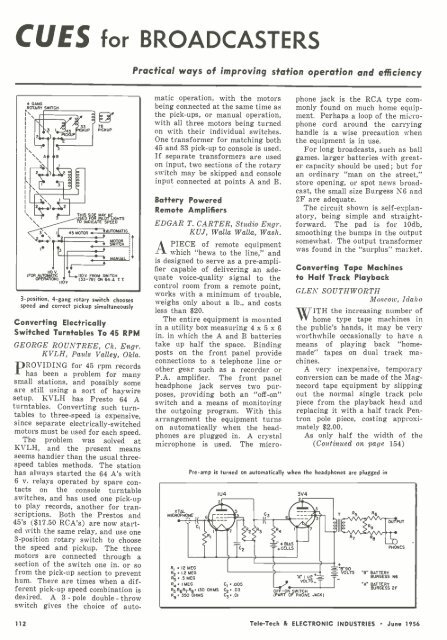TELE-TECH & - AmericanRadioHistory.Com
TELE-TECH & - AmericanRadioHistory.Com
TELE-TECH & - AmericanRadioHistory.Com
You also want an ePaper? Increase the reach of your titles
YUMPU automatically turns print PDFs into web optimized ePapers that Google loves.
CUES for BROADCASTERS<br />
Practical ways of improving station operation and efficiency<br />
4 GANG<br />
ROTARY SWITCH<br />
e<br />
Ilp<br />
I 73 -<br />
110 V.<br />
(FOR AEU<br />
USED FIOR PILOT CN ÚTS<br />
TO INDICATE SPEED<br />
45 MOTOR<br />
4<br />
*AUTOMATIC<br />
SWITCM<br />
MANUAL<br />
Ly110V. FROM SWITCH<br />
(33-76) ON 64-A TT.<br />
110V<br />
3- position, 4 -gang rotary switch chooses<br />
speed and correct pickup simultaneously<br />
Converting Electrically<br />
Switched Turntables To 45 RPM<br />
GEORGE ROUNTREE, Ch. Engr.<br />
KVLH, Pauls Valley, Okla.<br />
PROVIDING for 45 rpm records<br />
has been a problem for many<br />
small stations, and possibly some<br />
are still using a sort of haywire<br />
setup. KVLH has Presto 64 A<br />
turntables. Converting such turntables<br />
to three -speed is expensive,<br />
since separate electrically -switched<br />
motors must be used for each speed.<br />
The problem was solved at<br />
KVLH, and the present means<br />
seems handier than the usual three -<br />
speed tables methods. The station<br />
has always started the 64 A's with<br />
6 v. relays operated by spare contacts<br />
on the console turntable<br />
switches, and has used one pick -up<br />
to play records, another for transcriptions.<br />
Both the Prestos and<br />
45's ($17.50 RCA's) are now started<br />
with the same relay, and use one<br />
3- position rotary switch to choose<br />
the speed and pickup. The three<br />
motors are connected through a<br />
section of the switch one in. or so<br />
from the pick -up section to prevent<br />
hum. There are times when a different<br />
pick -up speed combination is<br />
desired. A 3 - pole double - throw<br />
switch gives the choice of auto-<br />
i<br />
matie operation, with the motors<br />
being connected at the same time as<br />
the pick -ups, or manual operation,<br />
with all three motors being turned<br />
on with their individual switches.<br />
One transformer for matching both<br />
45 and 33 pick -up to console is used.<br />
If separate transformers are used<br />
on input, two sections of the rotary<br />
switch may be skipped and console<br />
input connected at points A and B.<br />
Battery Powered<br />
Remote Amplifiers<br />
EDGAR T. CARTER, Studio Engr.<br />
KUJ, Walla Walla, Wash.<br />
APIECE of remote equipment<br />
which "hews to the line," and<br />
is designed to serve as a pre- amplifier<br />
capable of delivering an adequate<br />
voice -quality signal to the<br />
control room from a remote point,<br />
works with a minimum of trouble,<br />
weighs only about a lb., and costs<br />
less than $20.<br />
The entire equipment is mounted<br />
in a utility box measuring 4 x 5 x 6<br />
in. in which the A and B batteries<br />
take up half the space. Binding<br />
posts on the front panel provide<br />
connections to a telephone line or<br />
other gear such as a recorder or<br />
P.A. amplifier. The front panel<br />
headphone jack serves two purposes,<br />
providing both an "off-on"<br />
switch and a means of monitoring<br />
the outgoing program. With this<br />
arrangement the equipment turns<br />
on automatically when the headphones<br />
are plugged in. A crystal<br />
microphone is used. The micro-<br />
XTAL<br />
MICROPHONE<br />
R1<br />
12 MEG<br />
149 1.2 MEG<br />
R3..5 MEG<br />
phone jack is the RCA type commonly<br />
found on much home equipment.<br />
Perhaps a loop of the microphone<br />
cord around the carrying<br />
handle is a wise precaution when<br />
the equipment is in use.<br />
For long broadcasts, such as ball<br />
games, larger batteries with greater<br />
capacity should be used; but for<br />
an ordinary "man on the street,"<br />
store opening, or spot news broadcast,<br />
the small size Burgess N6 and<br />
2F are adequate.<br />
The circuit shown is self- explanatory,<br />
being simple and straightforward.<br />
The pad is for 10db,<br />
smoothing the bumps in the output<br />
somewhat. The output transformer<br />
was found in the "surplus" market.<br />
Converting Tape Machines<br />
to Half Track Playbcch<br />
GLEN .SOUTH WORTH<br />
Moscow, Idaho<br />
WITH the increasing number of<br />
home type tape machines in<br />
the public's hands, it may be very<br />
worthwhile occasionally to have a<br />
means of playing back "homemade"<br />
tapes on dual track machines.<br />
A very inexpensive, temporary<br />
conversion can be made of the Magnecord<br />
tape equipment by slipping<br />
out the normal single track pole<br />
piece from the playback head and<br />
replacing it with a half track Pen -<br />
tron pole piece, costing approximately<br />
$2.00.<br />
As only half the width of the<br />
(Continued on page 154)<br />
Pre -amp is turned on automatically when the headphones are plugged in<br />
CI<br />
lu4<br />
R4 I MEG C1 = .005<br />
R5R6R7R8.130 OHMS C2=.03<br />
R9. 350 OHMS C3..01<br />
R4<br />
_ 4 BIAS<br />
- +CELAS<br />
3V4<br />
ort2<br />
"A" I 112<br />
VOLTS_ T<br />
OFF-ON SWITCH<br />
(PART OF PHONE JACK)<br />
T-<br />
VOLTS<br />
"B" B<br />
BURGESATTERY S<br />
N6<br />
"A" BATTERY<br />
BURGESS 2F<br />
UT<br />
PHONES<br />
112<br />
Tele -Tech & ELECTRONIC INDUSTRIES June 1956
















